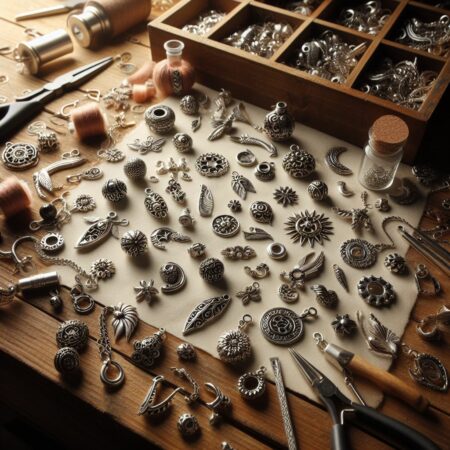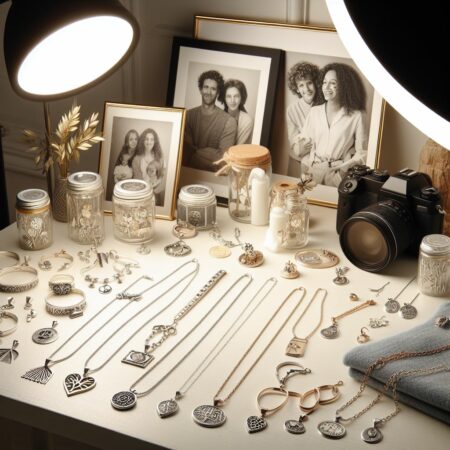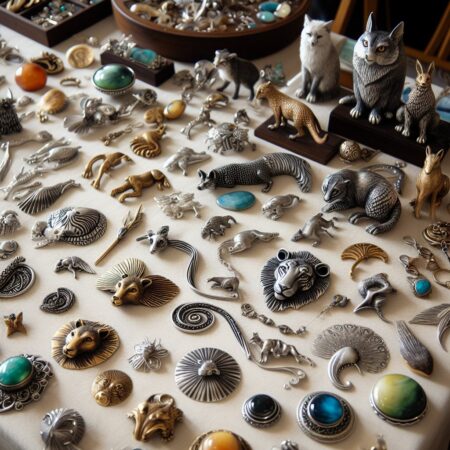The tradition of tying knots and using beading cords dates back over one hundred thousand years in different cultures. Historically, knotting served both functional and, perhaps more crucially, symbolic and religious functions.
For example, many of the world’s religions have used and utilized knotted prayer beads to aid in memorizing the correct number of prayers or chants required by their respective faiths. In truth, “bead” comes from the Anglo-Saxon biddan (to pray) and Middle English bede (prayer).
Over time, knots were no longer utilized just for ritual or religious purposes but also for personal decoration. For example, pearls, jewels, and other costly beads were strung on a string to keep them from rubbing against one another and prevent their loss if the cord broke. This still holds today. As a result, knotting between beads has become commonplace in the modern world, particularly for pearls.
If you’re interested in mastering beaded jewelry, check out our guides on beaded jewelry design (especially color consideration), preparing for your first bead jewelry project, and beaded necklace construction.
Beading Cords for Knotting
Choosing the ideal knotting cord for a project is a vital first step. In addition to bead hole size, other factors to consider include bead size, bead weight, and personal choice. Beads with tiny holes, such as pearls and expensive gemstones, are most secure when tied on silk or nylon with a small diameter.
Pearls are generally knotted on silk, but knotted leather looks amazing with large-hole pearls. On leather, waxed cotton, linen, satin, or other large-diameter cords, beads with ordinary to big holes look beautiful when knotted. Experiment with different bead and cord combinations to make unique knotted jewelry.
Silk and Nylon Cords
The most widely used cords for knotting between beads are nylon and silk. Whenever threads or cords are created, minute variances in the final result are possible. Even though the same dye may be used from batch to batch, slight color differences are expected. In addition, a finishing treatment can alter the thread or cord’s texture. Untreated threads and cords are always thinner and lighter than those that have been dyed, bonded, or otherwise treated.
Silk and nylon have unique qualities. In all circumstances, choosing the suitable diameter cord for the beads, you will be knotting is essential. In addition, the string should be sufficiently thick to prevent knots from pulling through the bead hole. Nonetheless, if a single strand of heavyweight silk or nylon rope is insufficient to keep knots from slipping into the bead holes, several alternatives exist.
How Much Cord Do You Need?
Multiplying the completed length of the project by four and then rounding up to the closest yard is a decent rule of thumb for determining how much cord you will need for a project. For instance, a 7-inch bracelet times four is 28 inches of string. Round up and use 1 yard of cord or 36 inches. 16 4 = 64 inches for a necklace of 16 inches. Round up and use 2 yards of cord or 72 inches.
First, try utilizing two or more strands of the cable. Next, try tying many knots on top of one another, or use a cord with a wider diameter, such as leather, waxed cotton, or satin. Each brand of nylon and silk cable has a different sizing technique, so when purchasing, pay particular attention to the cord diameter.
Silk Cord
The silk cord is typically used to tie knots between pearls, but it may also be used to tie knots between other tiny, lightweight beads, such as gemstones and Czech glass.
It is advisable to stretch it before use because it stretches readily. The silk cord is supplied in various sizes on spools and cards. The size of the pearl or bead hole dictates the selection of the right silk cord for knotting. Bead tips should be utilized when attaching a clasp to a silk cord.
Various widths and hues are offered on 12-ounce spools of spooled silk bead cable. Single, double, or triple strands of spooled silk can be used to tie knots between beads with a range of hole sizes. However, silk cable, particularly spooled silk, stretches. Hence it is advised that spooled silk be stretched before usage.
Twisted carded silk bead cable has a robust surface and a high gloss. Frequently, a flexible beading needle is already connected. It comes in a variety of yardages, diameters, and hues. Like spooled silk cords, carded silk cable stretches and should always be stretched before use.
Are you interested in advancing with beadwork? Learn to work with wire, how to organize your bead supply at home, and how to use different jewelry findings.
Other Varieties of Cord
Natural materials such as hemp, leather, linen, and cotton, as well as synthetic materials like as synthetic satin and elastic, are utilized to produce a variety of different cords for use in jewelry creation. In addition, these ropes are handy for tying knots between beads that cannot be strung with silk or nylon.
Hemp Cord
Hemp is a biodegradable, robust, and ecologically beneficial fabric. However, not all hemp cords are identical. For example, hemp twine is a coarse substance composed of multiple single strands of hemp yarn twisted together. It is mainly used in the home and garden.
Hemp cord, on the other hand, consists of numerous strands of multistrand yarn that have been twisted together and then twisted again. This procedure of double twisting provides a silky, high-quality cording suitable for jewelry manufacturing.
In general, hemp cable is utilized for knotting between bigger beads with larger holes, such as African trade beads, recycled glass, entire shells, and substantial wood beads. The appearance of hemp that has been knotted works well for choker necklaces and bracelets for males, as well as organic, bohemian-style jewelry for ladies.
Hemp cord is produced in various diameters and dyed in an extensive palette of hues. .5 millimeter, 1 millimeter, 1.5 millimeters, and 2 millimeters are standard sizes for hemp cord. There are other hemp threads with smaller diameters available. When adding a clasp, both coil crimps and fold-over crimps can be used to complete the ends of the hemp cable.
Leather Cord
Popular for knotting beads with bigger drill holes is the leather cord. It is composed of tanned cowhide that has been colored and shaped into a circular string with a diameter between 0.5 and 5 millimeters. The most frequent sizes of leather cord for knotting between beads with 2- to 3-millimeter holes are 1.5 and 2 millimeters. Greek cowhide is used to produce leather cording of the highest quality. Lower-quality leather cords from India and China tend to be less flexible and irregularly colored. A leather cord of superior quality will not break, split, or peel like inferior leather. The clasp should be attached to the leather cord using coil crimps.
Satin Cord
Satin cable is a circular, synthetic silk cording available in an array of gorgeous hues. It is available in 1mm and 2mm diameters and is used to tie knots between beads with 1mm or bigger holes. Sometimes, the one-millimeter satin cord is referred to as “mouse tail,” while a two-millimeter satin cable is referred to as “rat tail.” A clasp can be added to a satin cord using a coil or fold-over crimps.
Elastic Cord
Stretch cord, also known as elastic or elastic cord, is suitable for creating stretchy jewelry, mainly stretch bracelets. There are three primary varieties of stretch cord: circular transparent stretch cable, flat multistrand stretch floss, and cotton-covered elastic. A Stretch cord is not used to tie knots between beads, yet it is included in this book since it is knotted. Any variation of the stretch cord can be finished with a square or overhand knot tied with a drop of superglue or clear nail paint.
Created for garments, cotton-covered elastic may now be used to string heavier beads. This elastic cord is not suggested for jewelry creation since it stretches rapidly and readily. The cable comprises an opaque elastic core wrapped in densely woven cotton. It is only available in a few diameters and colors.
Bracelets and anklets are commonly strung with round stretch cords. Depending on the manufacturer, the diameters of round stretch rope range from 0.5 to 1.8 millimeters. Therefore, bead stringing does not require a beading needle when using a round stretch cable. In addition to a transparent variant, the circular stretch cord is available in various colors. Stretch Magic, available in various diameters, colors, and yardages per spool, is one of the most popular circular stretch cords.
Stretch floss, also known as gossamer floss, is a flat, fibrous, multistranded cord used for stringing bracelets and anklets. Stretch floss made from Spandex fibers retains its suppleness over time. One notable feature of stretch floss is that it begins to fray before breaking, making it obvious when a piece of jewelry requires restringing. In addition, stretch floss is simpler to use with a large-eye needle or twisted-wire needle for stringing beads. Opelon by BeadSmith and Elonga by Beadalon are two well-known gossamer floss products.
Braided Cord
Waxed linen, also known as Irish waxed linen, is a string formed from flax strands that have been firmly spun. The cable is treated with beeswax to increase its endurance and strength. The beeswax coating also assists in securing the knots in place. Waxed linen is famous for knotting between beads with tiny holes and micro macramé. It is offered on spools or by the yard in bead stores and is available in various weights or thicknesses known as plies. The extensive color palette of waxed linen is a significant selling point. Bead tips must be used when attaching a clasp to a waxed linen cord.
Waxed cotton is a thick, tightly woven cotton cord that has been gently waxed to increase its strength and longevity. The highest-quality waxed cotton is produced in the United States and is available in various sizes. Commonly manufactured in India and China, waxed cotton of inferior quality tends to be sticky and poorly waxed. Not only is waxed cotton helpful in knotting between beads, but also for macramé and bead stringing. If you’re exploring a vegan alternative to leather or suede, it’s also a fantastic substitute. Coil crimps or fold-over crimps may be utilized when attaching a clasp to a waxed cotton cord.






